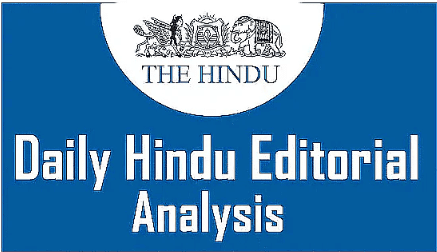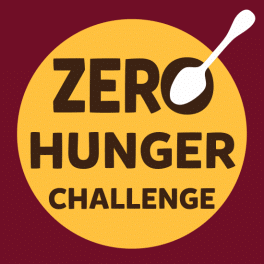UPSC Exam > UPSC Notes > Current Affairs & Hindu Analysis: Daily, Weekly & Monthly > The Hindu Editorial Analysis- 16th October 2024
The Hindu Editorial Analysis- 16th October 2024 | Current Affairs & Hindu Analysis: Daily, Weekly & Monthly - UPSC PDF Download

A food-sufficient India needs to be hunger-free too
Why in News?
Ending hunger, food insecurity and any form of malnutrition is one of the Sustainable Development Goals set to be realised by 2030. Such a goal is far removed from its realisation given rising conflicts, climate vulnerability and extremes as well as economic slowdown in regions that remain vulnerable and food deficient.
- Food security is the availability of food and the access to it by people. It means that people have enough food to eat all year round and that the food is safe and nutritious. This article aims to provide a comprehensive overview of the Food Security in India and its challenges and opportunities.'
- According to the World Food Programme, approximately 195 million people in India suffer from undernourishment.
- Around 43% of children in India face chronic undernutrition.
- In the Global Food Security Index 2022, India is placed at 68 out of 113 major countries.
There are Four Dimensions of Food Security:
- Availability: This dimension refers to the production and supply of food.
- Access: This is about people's ability to obtain food.
- Utilization: This involves how people use food.
- Stability: This relates to the food system's capability to handle shocks and stresses.
Why is there a need for food security in India?
- Population Pressure: India has a very large and growing population of over 1.3 billion people. This leads to a greater need for food, which puts a lot of stress on farming and food resources.
- Agricultural Productivity: Farming in India often has low output. This is due to several issues, including small landholdings, poor irrigation systems, outdated farming methods, and limited access to loans and technology.
- Climate Change and Natural Disasters: Unpredictable weather, such as droughts, floods, and extreme temperatures, negatively impacts crop production and livestock health.
- Water Scarcity: Indian agriculture relies heavily on the monsoon rains. However, these rain patterns are becoming less reliable, causing water shortages in some areas.
- Land Degradation and Soil Health: The quality of land is declining because of erosion, excessive use of chemical fertilizers, and poor land management, which threatens farming productivity.
- Storage and Distribution: Many food losses occur because of poor storage facilities and insufficient cold chain systems, leading to a lot of food waste.
- Poverty and Inequality: A significant number of people, especially in rural areas and disadvantaged communities, find it hard to buy and access healthy food regularly.
How to address the challenges related to food security in India?
- Sustainable Agriculture Practices: Support farming methods that are better for the environment, like organic farming, agroforestry, and integrated pest management. These methods improve soil health, lower the need for chemicals, and save water, which can lead to more productive and resilient farms.
- Irrigation and Water Management: Enhance irrigation systems by making reliable water sources more accessible, promoting water-saving technologies like drip irrigation, and adopting techniques for water harvesting and conservation.
- Research and Technology: Create new crop varieties that produce more, resist drought, and are less affected by pests. Encourage the use of modern techniques such as precision agriculture, remote sensing, and digital farming tools to make the best use of resources and boost productivity.
- Climate Change Adaptation: Use methods like crop diversification, crop rotation, and agroecology. Set up early warning systems for severe weather and help farmers adopt practices that can withstand climate changes.
- Storage and Cold Chain Infrastructure: Invest in advanced storage options, cold chain systems, and transport services to cut down on food losses and waste.
- Strengthening Food Distribution Systems: Improve food distribution networks through better logistics, effective supply chain management, and establishing connections to markets.

Government Initiatives
National Nutrition Mission (NNM)
- National Nutrition Mission (NNM) was introduced by the government as part of the POSHAN Abhiyaan initiative.
- The main aim of the NNM is to enhance the health of children, pregnant women, and lactating mothers.
- It addresses critical health issues such as:
- Stunting
- Undernutrition
- Anaemia
- Low birth weight in infants
- To assess the effectiveness of actions related to maternal, newborn, and child health as well as nutrition, the NNM uses a tool called the Lives Saved Tool (LiST).
National Food Security Mission (NFSM)
- Focus on districts that have low production levels but high potential.
- Develop new ideas based on different cropping systems.
- Plan according to agro-climatic zones and use a cluster approach to boost crop production.
- Increase emphasis on annual crops, especially pulses, and promote crop diversity.
- Encourage the use of advanced techniques such as:
- Quality seeds
- Integrated Nutrient Management (INM)
- Integrated Pest Management (IPM)
- Efficient use of inputs
- Resource conservation methods
- Build farmers' skills and support extension workers.
- Ensure timely aid reaches targeted beneficiaries by closely tracking funding.
- Combine different strategies and align district objectives with plans.
- Use agencies to evaluate the effects of the interventions and maintain a focus on results.
Zero Hunger Program
- It started in India in 2017 with the aim of improving agriculture, health, and nutrition.
- This program was created by the Indian Council of Agricultural Research, the Indian Council of Medical Research, the M. Swaminathan Research Foundation, and the Biotechnology Industry Research Assistance Council (BIRAC).
- Its main goals include:
- Developing agricultural machinery.
- Changing farming practices for better results.
- Setting up genetic gardens for plants that are rich in nutrients.
- Providing zero hunger training to help people learn about food security.
- The Zero Hunger Programaims to achieve the following:
- Decrease child stunting in children who are 2 years old and younger.
- Ensure that everyone has access to food throughout the year.
- Create stable food systems that work effectively.
- Improve the productivity and income of small farmers.
- Reduce food waste to make the best use of resources.
Eat Right India Campaign
- The Eat Right India movement was started by the Food Safety and Standards Authority of India to ensure that people in India can get food that is both healthy and safe.
- This initiative focuses on three main areas:
- Improving regulations
- Encouraging teamwork
- Empowering individuals
- The main goal of the Eat Right India Movement is to encourage people to eat nutritious, safe, and sustainable food in their communities.
- It understands that unhealthy eating habits can affect people of all ages and may lead to various health problems.
- To tackle these issues, the movement is working with:
- Restaurants
- Agricultural sectors
- Food producers
- Government ministries
- Professional chefs
- These partnerships aim to create positive changes in food habits and choices.
Food Fortification
- Eating low-quality food can cause problems like malnourishment and anaemia, especially among children and women in Indian communities.
- To help reduce malnutrition and anaemia, India has been adding nutrients to food since the 1950s.
- Food fortification means adding important nutrients to food using chemical, biological, or physical methods.
- Commonly fortified foods include rice, wheat flour, edible oil, salt, and milk.
- Unfortunately, about 40% to 60% of fortified food is not eaten by low-income women and children.
- This issue arises because some states do not buy fortified food, there is a lack of transparency in public supply chains about this food, and there are not enough distribution channels in rural areas.
- India has created five initiatives to fight hunger, all aimed at reducing hunger in the country.
- While some of these initiatives have met their goals, the fight against hunger is still ongoing.
- By adding more nutrients to daily meals, many people could be protected from hunger and illnesses.
- The government is aware of how serious this issue is and has set up programs to tackle it.
Way Forward
- Food security means that everyone in a country has enough nutritious food to eat, can pay for good-quality food, and can get it without any problems.
- Many people living in poverty find it hard to meet their food needs, but even those who are better off can face food insecurity during emergencies or crises.
- In India, a lot of people struggle with issues related to food and nutrition security, with certain groups being affected more than others.
- To make sure that food is available to everyone, the Indian government has created a food security systemthat has two main parts:
- A reserve stock of food to ensure there is enough supply.
- A public distribution system to distribute food to those in need.
- The government also runs various programs to help reduce poverty and improve food security.
- To achieve food security in India, a multi-pronged approachis necessary, which includes:
- Increasing agricultural production.
- Reducing inequalities in access to food.
- Improving infrastructure for food distribution.
- Raising awareness about food security issues.
The document The Hindu Editorial Analysis- 16th October 2024 | Current Affairs & Hindu Analysis: Daily, Weekly & Monthly - UPSC is a part of the UPSC Course Current Affairs & Hindu Analysis: Daily, Weekly & Monthly.
All you need of UPSC at this link: UPSC
|
38 videos|5293 docs|1118 tests
|
Related Searches
















